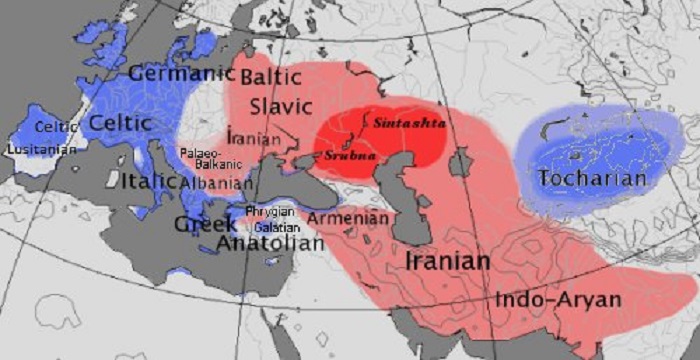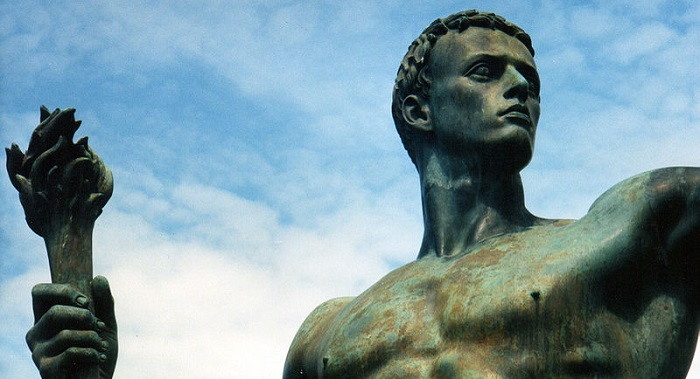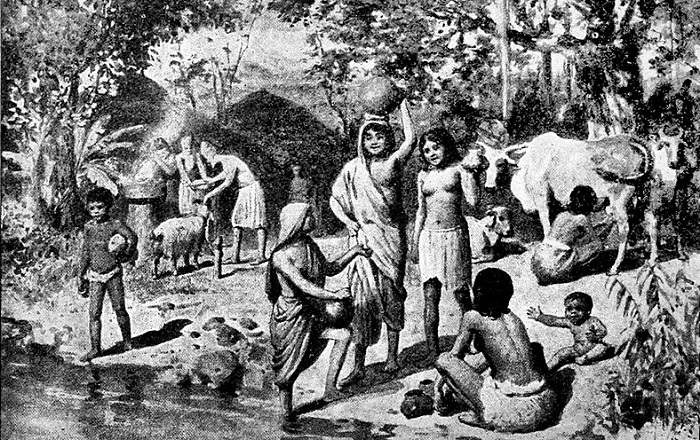Who Were the Aryans?
There are different theories associated with the Aryans, their origins and possible migration/invasion in the Indian subcontinent. While the Indo-Iranian people used the term Aryan as self-designation, the Indic people of the Vedic period in India and the closely associated Iranian people used it as an ethnic label for themselves. The term used by the Indo-Iranian people also forms the etymological source of the country name Iran. It is regarded by many that the Aryans crossed the Hindu Kush Mountains and migrated into the Indian subcontinent by 1500 BCE while several others believe that Aryans are indigenous to India. A theory suggests that possibly the light-skinned Aryans invaded and conquered ancient India and played instrumental role in shaping Indian culture, particularly the Vedic religion
(Source: https://en.wikipedia.org/wiki/Aryan, https://www.ancient.eu/Aryan/
https://www.britannica.com/topic/Aryan)
Homeland of the Aryans – Where Did the Aryans Come From?
Origin of the Aryans and where they came from is still a subject of debate. Many historians refer the term Aryans with those who spoke Indo-European languages, including English, Russian, Greek, German, Persian, Latin and Sanskrit. These people were considered to have settled in ancient Iran and the northern Indian subcontinent in prehistoric times. During the mid-19th century the theory of an “Aryan race” developed and prevailed until the mid-20th century. Such theory suggested that homeland of ancestors of the Indo-European people were located in northern Europe, which meant that Indo-Europeans were originally of a Nordic racial type. The theory proposed that ancient India was possibly invaded and conquered by light-skinned Aryans from the north. According to the hypothesis modes of social organization, religion and literature of these people eventually aided in shaping the Indian culture, especially the Vedic religion. It is regarded that the Aryans crossed the Hindu Kush Mountains and migrated into the Indian subcontinent by 1500 BCE.
The term Aryans is also used with reference to non-Semitic white-skinned race of mankind.
 Image Source: https://en.wikipedia.org/wiki/Aryan
Image Source: https://en.wikipedia.org/wiki/Aryan
Some theories suggest that Aryans were diverse group of people living in various areas of the ancient world including parts of Europe, Mediterranean, north western India and central Asia. According to a theory Aryans were considered to be ancestors of “some” Germans, Romans, Greeks, Persians, the Celts and Indians. They worshipped different gods and goddesses and applied fire in rituals. The many languages they spoke are regarded to have developed into the Indo European languages of the day. Group of Indo-Iranian Aryans were considered to have settled in Iran and areas of north western India. Different scholars have different opinions with regard to the original homeland of Aryans. Opinions of Indian historians can also be categorised in two different theories, one that support Indian origin of the Aryans and the other that suggest non-Indian origin of Aryans.
A common theory is that the Aryans originated in the Russian plains and possibly migrated to Europe and in Mesopotamia. There is also a belief that they arose in Europe and migrated eastward. According to some theorists Aryans founded the ancient civilizations of Mesopotamia and were thus the first civilized people of the world. Such hypothesis fostered during the Nazi regime of Germany to strengthen its idea of Aryan supremacy. It was even claimed by the Nazis that Godlike super humans from another world created the Aryans.
Among noted historians, homeland of the Aryans was proposed to be Central Asia by Max Mueller; Arctic Region by B.G.Tilak; Germany by Nazi/German Scholars; India by Dr. Subhash Kak and others. Many of the scholars consider original habitat of the nomadic Proto-Aryans to be Central Asia. This includes the large plains of ancient Chorasmia, Sogdiana and Bactria and adjoining regions to their north in Eastern Iran. According to Pokorny it was an extended area situated in Russia between Vistula and Weser and up to Volhynia and White Russia. Nehring mentioned the area as Southern Russia.
(Source: https://www.hinduwebsite.com/hinduism/concepts/aryan.asp)
 Image Source:https://en.wikipedia.org/wiki/Aryan
Image Source:https://en.wikipedia.org/wiki/Aryan
When Did the Aryans Come to India?
Opinions which support the Aryan invasion theory differ with respect to expansion of the Aryans in the Indian subcontinent. One opinion suggests that the Aryans came in large groups and initially settled in north-western India. With time they relocated near the Gangetic valley and in the north eastern and southern parts of India. During the 1840s, German linguist Friedrich Max Muller translated one of the four sacred canonical ancient Indian texts (śruti) of Hinduism, the Rig Veda. According to Max Muller, he found evidence that a group of Hindu Brahmins, who he described as “the Arya”, invaded ancient India. He also believed that Aryan was a linguistic category instead of a racial one. Eventually scholars applied his theory of invasion to suggest their own perspective of racial conquest through the Indian Ocean and South Asia. New Zealand polymath Edward Tregear opined in 1885 that a wave of Aryan populace overwhelmed across India and extended towards south through the East Indian archipelago islands and hit as far as New Zealand.
According to one school of thought, ancient India was enriched with a highly developed civilization, the Indus Valley Civilization, before the Aryans migrated. The civilisation prospered in the basins of the Indus River. It extended from what today is northwest India and Pakistan to northeast Afghanistan. The Aryans, a large group of nomadic cattle herders, migrated to the Indian subcontinent by crossing the Hindu Kush Mountains by 1500 BCE. Such considerable migration was viewed by many as an invasion. A group of scholars believed that such emergence of the Aryans led to the downfall of Indus Valley Civilization, however this theory presently does not hold unanimous acceptance.
 Image Source: https://ne.m.wikipedia.org/wiki/%E0%A4%9A%E0%A4%BF%E0%A4%A4%E0%A5%8D%E0%A4%B0:Aryans_entering_India.jpg
Image Source: https://ne.m.wikipedia.org/wiki/%E0%A4%9A%E0%A4%BF%E0%A4%A4%E0%A5%8D%E0%A4%B0:Aryans_entering_India.jpg
One of the theories suggests that the first Indo-Aryans possibly migrated into northwest India, in the Panjab and adjoining areas around the middle of the 2nd millennium B.C. They crossed the passes of the Hindu Kush mountain and thereafter they defeated hostile groups of peoples named in Vedic texts as Dāsa or Dasyu to spread further. The exact routes taken by these Aryans to enter the Indian subcontinent and their earlier dwellings are however not backed by any documentary or archaeological evidence. Many assume that about 2000 B.C., the Indo-Aryans left the Proto-Aryan homeland. French archaeologist R. Ghirshman said that the Indo-Aryans left in two groups. According to him, the first group went to Northern Mesopotamia and the second reached India crossing the Hindu Kush.
The one theory that has gained ground with time is that the Aryans are indigenous to India. There are no circumstantial evidence to confirm that the Aryan invaded India as suggested by the British and other European scholars. The ancient Hindu texts like Dharmashastras and Sutras mention the term Āryāvarta for parts of the Indian subcontinent. The term in Sanskrit literally means the “abode of the noble or excellent ones (Aryas)”, that is the land of the Aryans. Supporters of the theory mention that Buddha, a Kshatriya and a man of noble birth, was called Aryaputra, i.e. son of Arya, by his followers. Same was the case with Mahavira.
(Source: https://en.wikipedia.org/wiki/Aryan https://www.ancient.eu/Aryan/ http://www.iranicaonline.org/articles/aryans
https://www.britannica.com/topic/Aryan)
 Image Source: https://kn.wikipedia.org/wiki/%E0%B2%9A%E0%B2%BF%E0%B2%A4%E0%B3%8D%E0%B2%B0:Aryans_settling_in_India.jpg
Image Source: https://kn.wikipedia.org/wiki/%E0%B2%9A%E0%B2%BF%E0%B2%A4%E0%B3%8D%E0%B2%B0:Aryans_settling_in_India.jpg
Aryans and the History of Archaeology
The theory of Aryan invasion is predominantly based on imprecise translation of Vedic texts and is hardly manifested by any archaeological evidences. Although several excavations were carried out in the sites of the Indus-Sarasvati Civilisation, the civilisation’s language however could not be determined till present. Thus archaeologically there is even lack of literary support to this theory. Some skeletons were unearthed from a few sites during an excavation in the early 20th century. Supporters of the Aryan invasion theory considered these as archaeological evidence illustrating massacre of locals of Indus Valley Civilization by the Aryans. But those who opposed the theory countered that no war-like damage were visible from the skeletons and thus could have been there due to inappropriate disposal. Many archaeologists and historians came to the conclusion that it was not the hypothetical Aryan-Dravidian battle but the disappearance of Sarasvati River around 1800–1900 BC that ended of the Indus-Sarasvati Civilisation. Present day satellite imagery manifests presence of a dry riverbed that is considered to be that of the lost Sarasvati River.
Lack of archaeological evidence supporting the Aryan invasion theory with time led it to get replaced by the Aryan migration theory. However some historians and archaeologists even discard the Aryan migration theory and instead support the indigenous Aryan theory. The latter reject the notion of separate Aryans or Aryans-Dravidiands and consider that they are one and the same people as in the present day. According to many of the professional archaeologists in India, there is no archaeological evidence to back external origin of the Indo-Aryans. Thus the issue associating identification of the Indo-Aryans in the archaeological record within the Indian subcontinent remains.
(Source: http://www.oxfordscholarship.com/view/10.1093/0195137779.001.0001/acprof-9780195137774-chapter-12)
Myths Associated with the Aryans
According to linguistic studies, the Aryan language garnered dominance over the local languages after the Aryans migrated into the Indian subcontinent. With time they also embraced an agricultural lifestyle that became widely established by around 1000 BCE. Although there are no historical records of such era, a mythical record exists in the form of the Vedas. These are highly regarded ancient Indian religious texts composed in Vedic Sanskrit. Although the Vedas include stories of military conflicts and other hostilities, such legends are not manifested by any evidence and thus the question of historical reliability of these accounts remains.
(Source: https://www.ancient.eu/Aryan/)


